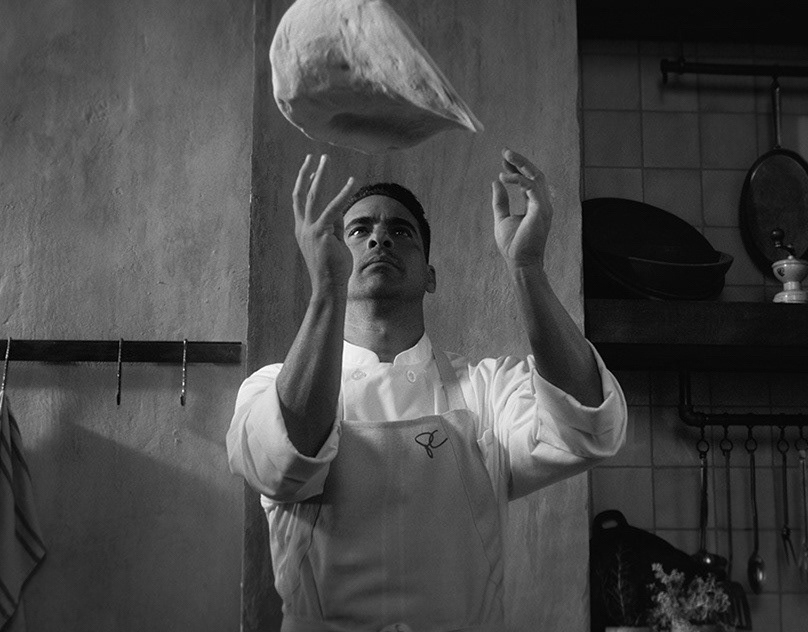Young and beautiful, Life is enthralled with the world around her. Death is enamored by Life's innocence and vivacity, but his attempts to connect with her are fleeting. Despite Death’s awkward and destructive path, Life recovers from each loss with graceful fortitude. In Death’s gloom, a passionate love for Life blossoms.
This very short film was conceived by Clara Lehmann & Jonathan Lacocque, and completed nights and weekends from 2014 to 2015. It's our first short narrative and was an experiment to see whether we could pull it off, and to begin the process of working on more narrative projects in the future. We hope you enjoy!
See it at our site:
http://www.coatofarmspost.com/portfolio/death-loves-life/
http://www.coatofarmspost.com/portfolio/death-loves-life/
Directed & Produced by Clara Lehmann & Jonathan Lacocque
Written by Clara Lehmann
Edited by Jonathan Lacocque
Art Direction by Henrique Lira
End Typography by Isabella de Lião
Motion Design & Animation by Ricardo Nilsson
Additional Animation by Rachel Yonda
Original Music by Marius Kirsten
Sound Design by Shawn Wilson
Surround Design & Mix by Matt Sauro & BAM Studios
Voices by Elaine McMillion Sheldon & Kerrin Sheldon
Written by Clara Lehmann
Edited by Jonathan Lacocque
Art Direction by Henrique Lira
End Typography by Isabella de Lião
Motion Design & Animation by Ricardo Nilsson
Additional Animation by Rachel Yonda
Original Music by Marius Kirsten
Sound Design by Shawn Wilson
Surround Design & Mix by Matt Sauro & BAM Studios
Voices by Elaine McMillion Sheldon & Kerrin Sheldon
Here, we hope to give you a behind-the-scenes look into what it takes to create an animated film — from scripting to scoring. A few years ago, Coat of Arms’ Producers Clara Lehmann and Jonathan Lacocque read Life of Pi and were struck by one particular quote in the book:
“Life is so beautiful that death has fallen in love with it, a jealous, possessive love that grabs at what it can. But life leaps over oblivion lightly, losing only a thing or two of no importance, and gloom is but the passing shadow of a cloud…”
— Yann Martel, Life of Pi
The personification of death and his envious desire for life intrigued us. We loved the imagery Martel’s words evoked. From this passage, we were inspired to write a short film, with the hope that we could find a fun and playful way to explore such a heavy topic in under four minutes of screen time.
Why so short? To be completely honest, it came down to money. We knew we wanted to animate the short and that we would be financing the endeavor ourselves. To keep the budget reasonable, four minutes was the maximum we could afford to invest.
After outlining the story with Lacocque over stout coffee and buttery toast, Lehmann forged ahead by writing a short script that embraced a young but forbidden love between a boy named Death and a girl named Life. Death and Life collide in perfect opposition to one another, and the script is interspersed with some semi-dark comedic moments.
Death is an awkward, stiff character, who is enthralled by Life’s vivacity and innocence. In his attempts to befriend her, Death missteps at every encounter with Life. Meanwhile, Life is an airy, organic, and sunny character that lives in every moment fully.
We chose to exclude dialogue from the film. This decision derived from a desire to keep both characters somewhat pure. We wanted viewers to live with and pull emotion from each characters actions, their environment, and the music.
Although the subtext is rather foreboding, this film is meant to be fun and light-hearted. It’s a cartoon and plays off of that medium purposefully. We even chose illustrator extraordinaire, Henrique Lira with the express wishes to give the piece more warmth. We first noticed his work on Vimeo. Here’s just one example of Lira’s artistic talent:

ILLUSTRATION: CHARACTER DESIGN
Upon completing the script, we sent it to Lira to gauge his interest. He loved it! So, we outlined a schedule and got started. Because character design directly informs the design and illustration of every scene and prop, Lira started with the characters: Death, Life, and Birdie. Lira’s process for illustrating characters is fluid and fruitful. First, he created several silhouettes and asked us to select three.
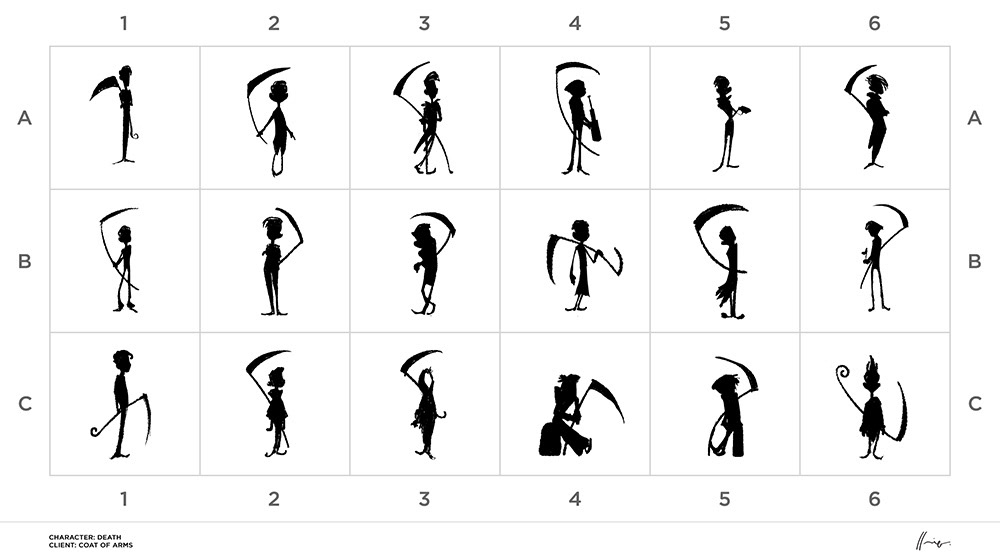
For Death, we didn’t want him to be too imposing or scary, but rather gangly and sweet like many of the characters you might find in a Tim Burton film. From the silhouettes Lira sent, we selected A4, B6, and C5. Along with these selections, we asked Lira to give Death a more compact, shorter sickle that could hang from his back. Lira added slightly more detail to each sketch and subtle revisions followed.
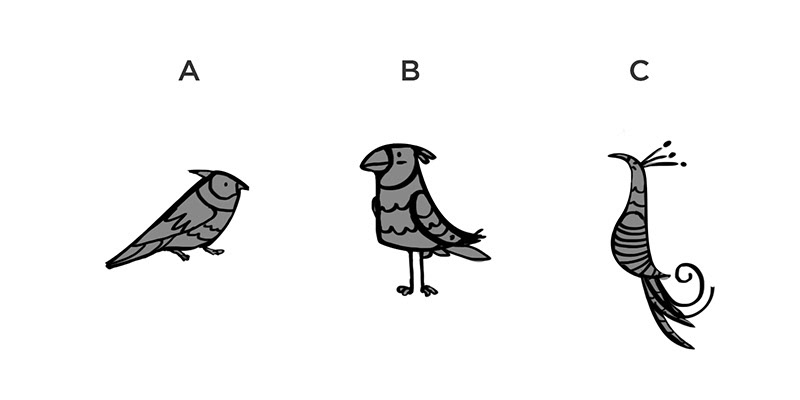
For Birdie, a secondary role in the film, we wanted to keep the design simple. We didn’t want an exotic bird that would distract from our main characters, and we wanted to keep the bird realistic. It would have been easy to push the characters, including the bird, to a more fantastical level, but we aimed to find a balance between semi-realistic and vibrant. We whittled down the options to the three birds depicted above and chose to pursue A as Birdie.

For the character Life, we wanted her to exude a purity and innocence while reflecting the natural environment around her. Life’s character embodies elements of mother nature, so she needed to feel more organic and colorful. Life’s dress, for example, is made of flower petals, a leaf charm hangs around her neck, and her long, red braids swing down to her waist.
Next, comes the color. In painting the characters, we wanted to balance natural, earthy tones with vibrancy for Life; and we wanted more subdued blues, purples, and grays for Death. Here’s a process video that depicts Lira painting Death:
ILLUSTRATION: ENVIRONMENTS
Once the character illustration and painting were completed, it was time to set the stage and create environments or scenes these characters would live in. During each stage, like any film, the script changed in some ways. The development of the characters told us new things about the story, which influenced the environments.

For example, as Lira designed the environments, he decided that the journey through each scene should reflect the seasons (Spring, Summer, Fall, and Winter). Beginning in Spring and Summer and ending in Fall and Winter, each act of the script is reflected in its corresponding season.


This fit perfectly with our story and gave the acts more meaning. Not to mention, it allowed us to play with time — making it so that the four-minute story took place over a longer period of time.
ILLUSTRATION: STORYBOARDING
Storyboarding is an essential part of any video, but we were especially excited to see our film develop beyond the individual illustrations. During this process, the story is further defined and discovered.
One script change that developed during this phase was how we transitioned from Life’s introduction to the scene where we introduce Death. We chose to follow leaves blowing in the wind across the frame to make this transition subtle and dynamic rather than cutting directly to Death.

As the script outlines, we introduce Death perched in a tree and peering at Life through a spyglass. Suddenly, he loses his footing, falls out of the tree, breaks his neck, and kills the flowers below the tree with his fall. This playful, but morbid introduction sets the tone for Death’s character, and it allowed us to display the film’s title cleverly carved into the tree’s trunk.
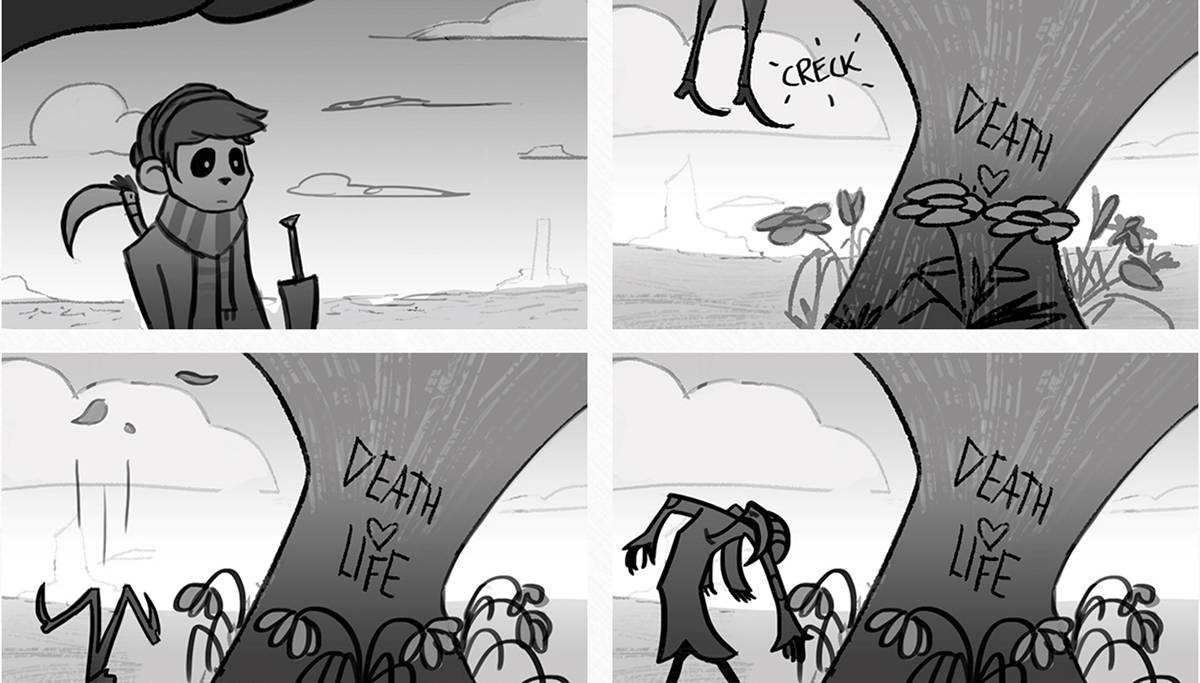
While boarding and developing the illustrations, Lira created a new character: Death’s sickle. In our original script, Death carried an inanimate sickle. As Lira illustrated Death, he felt that a bird-like sickle would allow us to add some comic relief to Death’s character. We decided the sickle’s responses should reflect how the audience may feel or respond to his actions.
For example, as Death tries to woo Life, the sickle is shocked and dismayed by his actions, which gives the audience a license to feel more comfortable with their own reactions to Death’s mistakes. The hope is that this character will help us laugh at Death’s unsuccessful attempts to win Life’s love and approval. A small character, but one of our favorites!
COLOR SCRIPT
With storyboards complete, it was time to work on the color script. A color script gives directors an opportunity to review and map out the lighting, emotion, and color of a film. You see your entire animated film at a glance.
Every Pixar film, for example, has a color script. Here is the color script from Up, created by the talented artist Lou Romano. If you haven’t seen Up yet, this color script has SPOILERS:
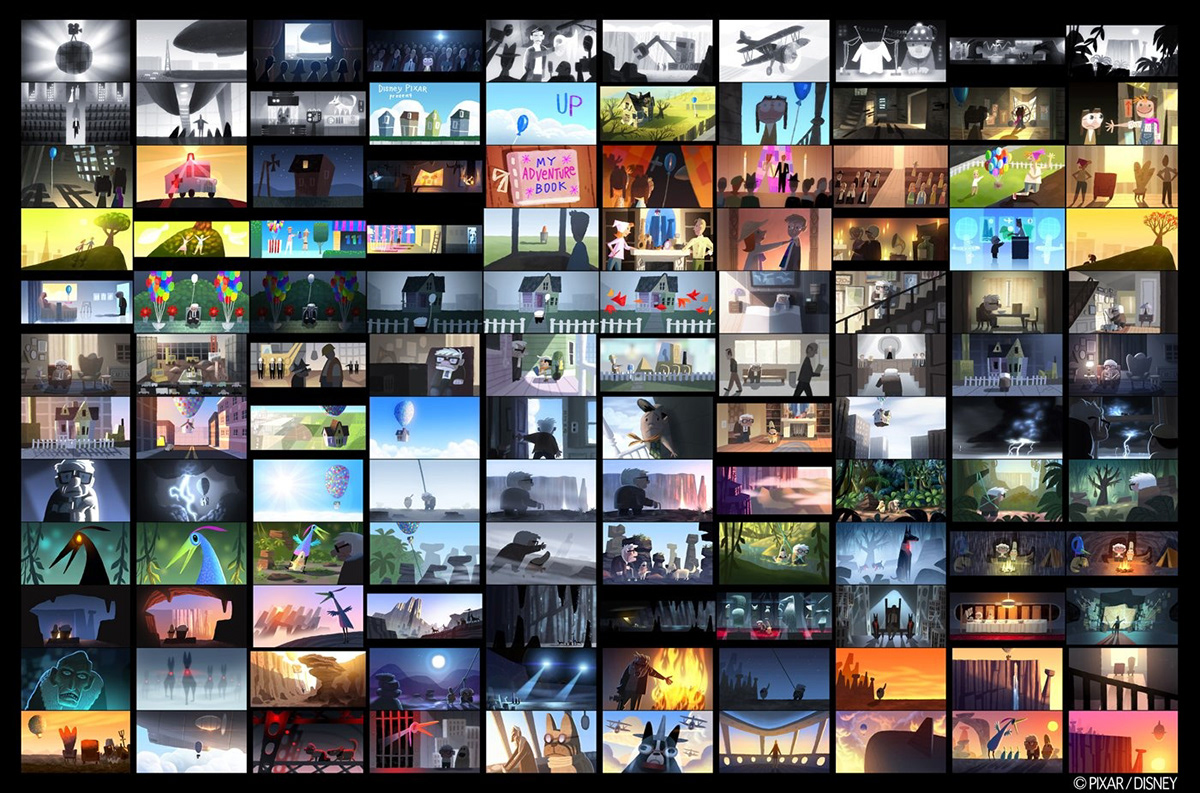
There is an interesting article in Slash Film that gives the following description of Up’s color script:
“Click on the image above to enlarge. You will notice that the beginning of the film is heavily saturated. When Ellie enters Carl’s life, she brings much-needed color to the frame. When Ellie dies, Carl’s life again becomes more mundane and colorless.
But the color returns, as with the memory of Ellie and her sense of Adventure, when Carl begins his journey with Russell. Each new character brings a new level of color and brightness. Also, notice how the scenes of adventure are bright, and the scenes of danger get dark.”
We set a goal to go through all four seasons in Death Loves Life. As you will see, we move from bright, vibrant, and warm colors to dark and arid gradually.

BOARD-O-MATIC
In the meantime, we spoke with The License Lab, a music licensing company that we often work with for our commercial and corporate projects. They were interested in collaborating on our short film and offered their library of music for use in the film. It was a bold gesture and one we appreciate greatly. After reviewing many tracks from their site, we chose four.
With our music selected and the boards and color script completed, we created an early board-o-matic with initial sound design by Shawn Wilson. The hope was to push the board-o-matic as far as possible to ensure we had the timing of the music and sound design right so that the animation would require fewer timing changes.
ANIMATION
Along with illustration, Lira animates as well. However, he was pitching his own animated series with Nickelodeon and needed time to work on his pilot. So, we all agreed we should bring another artist on board for the animation phase. And what a great decision it was!
As Lira prepared the characters for animation, designed all the props in each scene, and finalized sceneries, we readied one of our favorite illustrators/animators, Ricardo Nilsson for his role.
Prior to this project and since then, we have worked with Nilsson several times on commercial projects. His ability and experience as both an illustrator and animator made the hand-off seamless. He and Lira were able to easily pass files back and forth, and Nilsson could manipulate them as needed.
It also helps that both gents speak Portuguese (Lira hails from Brazil and Nilsson from Portugal). While they conversed in English for our meetings and group emails, it was exciting to see two exceptional artists on either side of the “pond” represent for the Portuguese speakers of the world!
Nilsson worked for three months, animating Death Loves Life by himself. It wasn’t until the end of animating that we brought in some additional help with Rachel Yonda. She helped make tweaks and finesse character movements in our final push to complete the film’s animation.
Here’s a draft of the opening sequence Nilsson sent us. To give you an idea of how much work goes into each scene, take a look at this rough and review the notes below.
Coat of Arms’ feedback on Scenes 1A to 2B:
1. In the beginning, let’s have the two closed flowers vibrate only once or twice before opening.
2. Allow the blur to hold longer, as we see her enter frame, let’s rack focus slowly to her.
3. Have the clouds moving slightly throughout.
4. We feel like her arms need to be re-worked. They look weird flapping right now. Maybe she’s skipping a little so her arms aren’t always flailing. They may come down or bend a bit. Something a little closer to the dancing later in the film, but not as intense. When she skips, make sure her skirt and braid bounce fluidly as well.
5. Soften her facial expression and vary them a bit. Right now her eyes are huge and don’t express much. Let’s add a bit more interest, emotion, etc.
6. Around 00:10 the movement of the flowers in the background is distracting — reduce the movement slightly.
7. Can the shadows move on the tree as well?
8. Animate the pieces of hair (near her face) with a bit of bounce.
9. Around 00:15, when the wind blows, have her close her eyes, step forward as if pushed by the wind, and maybe scrunch her eyebrows to protect her eyes as the wind blows.
10. Around 00:17 have slightly less movement in the field of flowers again. It’s just a little too much.
11. Make Death’s legs kick back and forth/swing.
12. Add a small lens flare or reflection on the end of Death’s scope, so we are drawn to it.
And here’s the final opening so that you can see the amount of work Nilsson put into the animation:
SCORING
Despite the fact that The License Lab kindly donated a library of tracks to us, we felt an original score would be best for the film. That’s when we approached German composer and musician, Marius Kirsten. Kirsten had worked with Henrique Lira on his film Harrdy and came with glowing references. Over a Skype conversation and several emails, we defined the style:
“Overall, the piece should feel light and happy, but the mood of the music should follow the seasons: Spring, Summer, Fall, Winter. And the time of day: Morning, Afternoon, Evening, Night.
The characters, Life and Death, are introduced in Spring/Summer, when the flower scene takes place. Life dances through summer. Death gains some confidence to approach Life but kills her bird accidentally in the Fall.
And finally, the two come together in the barren field in Fall/Winter, when Life dies. Hints of life continue to populate scenes (even at the end) to give us hope. The audience should be left feeling fulfilled and at ease.
Death, overall, is a bit more awkward, shy, and doesn’t understand himself. Life is a free spirit, joyful and wears her emotions on her sleeve. Together, these two harmonize perfectly.”
We continued to break down the script by important moments and express the mood for each beat so that Kirsten could get started on scoring. Over three weeks, Kirsten drafted a score and completed two rounds of revisions.
Some of the more complex and time-consuming notes included removing and playing down the defining instrument (the flute) chosen for Life’s scenes, adjusting a few of the transitions between scenes, and reworking and finessing the music where Life dies. Kirsten worked very hard to balance the light and melancholy tones of the film. And as you can imagine, he likely spent a lot of hours here:
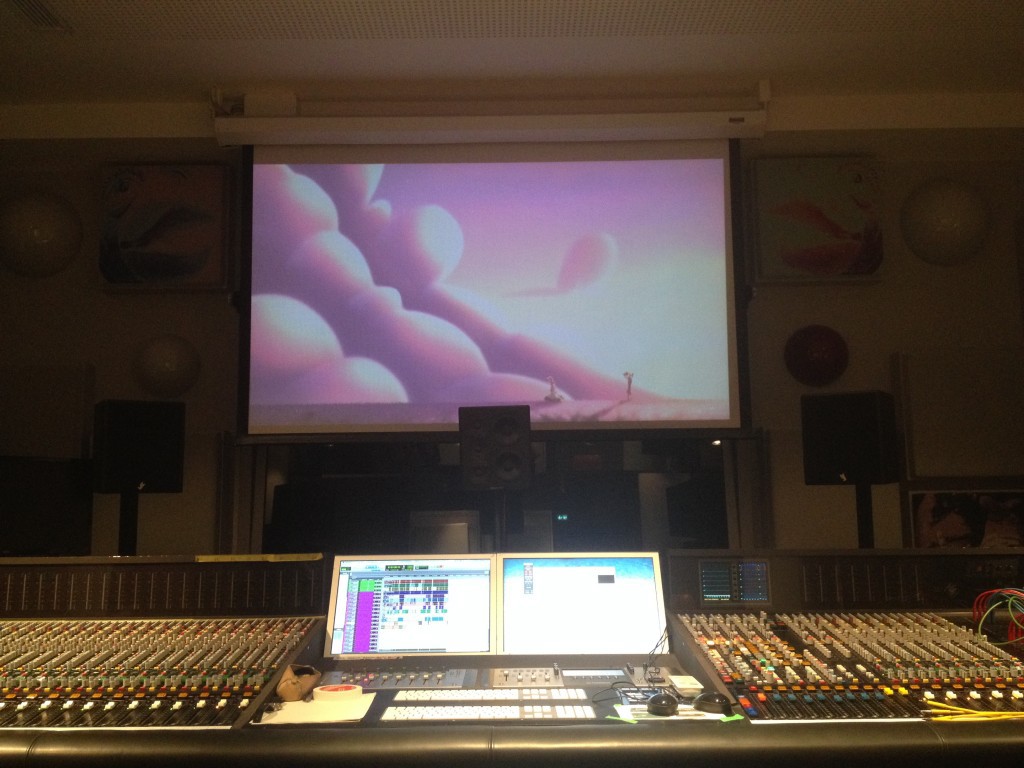
SOUND DESIGN
The last step, but a very important one for finishing any film, was sound design and mix. Shawn Wilson performed the sound design and BAM Studios’ Matt Sauro did the 5.1 surround sound mix. When we initially reached out to Wilson, we explained,
“The sound will have to really sell this. The environment of each scene, from the birds to the wind, is really important. We want the sounds to be rich and to bring the viewer into this world. Feel free to have fun being creative on this first pass.
This is a cartoon, so the sounds don’t all have to be from the ‘real world’ – they can be slightly different, have effects or have different tones than we might expect. We don’t want to make it weird, but we want this to be bright and vibrant like the artwork.”
Initially, we also paired specific sounds for each character. Nature or natural sounds were paired with Life, and wilting and bone-rattling sounds were for Death. A lot of the more subtle instances of this made it into the film, but we ended up scrapping a good deal of this language as it was too heavy-handed. The music also helped define the characters as the flute is primarily used for scenes with Life and the bassoon is used for Death.
When Sauro and BAM Studios got involved, they did some cleanup, leveling, and equalization. Sauro added a few sound effects the scene where Life dies as that scene, in particular, is the climax of the story and artistically interesting. The collaboration, between BAM/Sauro and Wilson proved very worthwhile.
Our filmmaker friends, Elaine McMillion Sheldon and Curren Sheldon performed the voices for Life and Death. These two clearly had fun recording. While scrubbing through the voiceover, we noticed that Elaine kept humming the ‘Star Spangled Banner.’ She must have been feeling very patriotic that day. In fact, one of their cute outtakes made it into the cut. At the end of the credits, Elaine starts humming. She laughs. Curren cracks up and says, “That’s a wrap.”
Death Loves Life was at screened several Academy accredited festivals, including the Los Angeles Shorts Film Festival, the West Virginia International Film Festival, the Gdansk International Animation Film Festival in Poland, and the Cleveland International Film Festival.





